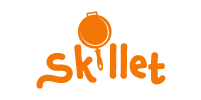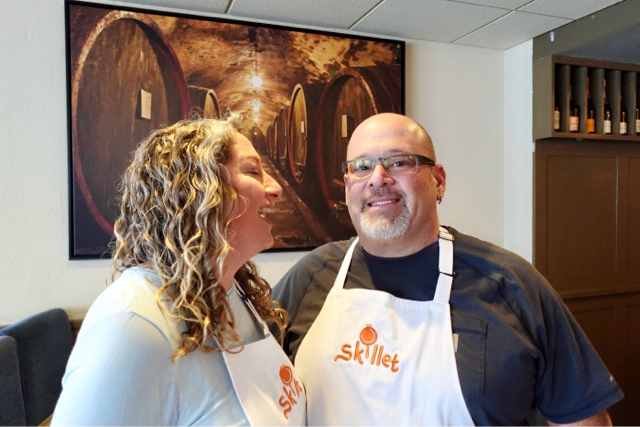
Sipping Smarts: 3 Ways to Make the Most of Your Wine Tasting Experience
Discover how to elevate your wine tasting experience with these 3 expert tips.
From pre-tasting research to local insights and note-taking, savor every sip like a seasoned sommelier.
Hey there, fellow wine enthusiasts! Whether you’re a seasoned oenophile or a curious newbie, embarking on a wine tasting adventure is always an exciting journey for your taste buds. And what better way to indulge your senses than by exploring the art of wine tasting? At Skillet, we’re all about helping you make the most of life’s flavorful moments, so, let’s uncork the secrets to enjoying your next wine tasting experience to the fullest.
We spent our honeymoon in wine country, California. (I think. It was a blurry 2 weeks.) We’ve also been to several Wine Expos, wine tasting dinners and events and have hosted our own wine tasting parties. Here’s our game plan for when we want to visit wine country or head out to the local wineries for wine tours and wine tastings. Follow these steps and you’re sure to have a memorable wine tasting encounter.
#1 Do some homework ahead of time.
There are some who like to plan and there are some who just like to see where the wind takes them. No matter how you approach life, it is helpful to do at least a little bit of research before your wine tasting encounter. It might sound like homework, but trust us – this homework comes with a tantalizing reward.
Start by familiarizing yourself with the basics of wine tasting. What are the key aromas and flavors to look for? How does the appearance of the wine provide clues about its age and variety? When you arm yourself with some foundational knowledge, you’ll be better equipped to appreciate the subtle nuances of each sip.
If you have booked a wine tasting for example, we suggest you try to see the menu ahead of time. It’s important to know if you need to arrive on an empty stomach, ready to taste all the dishes that have been carefully paired with the wine offerings. If the wine tasting experience doesn’t have any promise of nosh, you should definitely have some light snacks before you go.
If you’re in “wine country”, we suggest doing what we do. Every night at dinner, (while sipping wine of course) we would review where we went for the day, the wineries we found and enjoyed and then would pick a winery we had yet to visit and would find it on the map. Once we located it, we spent the time looking up the wineries and must-see spots between our inn and our final destination.
The planner in me satisfied, we’d head out the next day after breakfast, and start driving. I play navigator and would look ahead at road signs and the GPS for spots that didn’t come up in our research the night before and then direct him where to turn for “The best tamales in the area”, local historical spots, and, of course, wineries.
This combination of research and “winging it” has led us to some favorite spots. Try it next time you’re heading to any new destination and be ready to give up your pre-planned agenda when you stumble upon a surprise gem you never knew was there.
#2 Tap into local wisdom
Picture this: you’re standing in the heart of a breathtaking vineyard. You can just smell the sun hitting the earth. You have your wine glass in hand, but you’re craving some insider insights to be sure you’re not missing a thing. Here’s where “Ask a Local” becomes your secret weapon.
When you’re visiting a wine region, whether it’s the renowned Napa Valley or a hidden gem closer to home, don’t be shy about striking up a conversation with the folks who know the terroir best – the locals! These individuals have a wealth of knowledge about the history of the area, and may be able to share about the unique characteristics of the wines in their region.
Not only can they guide you toward the must-visit local wineries, but they can also offer tips on restaurants, bars and the most scenic spots for that perfect Instagram-worthy shot. It’s like having your own personal sommelier, and who could say no to that?
When traveling through Pasa Robles, California during our honeymoon, we stopped in for a wine tasting at a winery we couldn’t wait to visit. Between sniffing, swirling and spitting (don’t believe that last part), we chatted up the other couple at the wine tasting counter and discovered they were locals. As it ends up, one of our new friends was a sous chef at a restaurant he described as, “Very good. It’s a bit fancy, but…you’re on your honeymoon!”. We left the tasting room with dinner reservations for that evening, thanks to him making a quick call.
If we hadn’t been social, we never would have found our way to Auberge du Soleil in Rutherford, CA., a Michelin Star winner for 15 years. The food was over the top and the sommelier made some excellent local recommendations for places to visit during the rest of our visit.
It doesn’t matter which wine country you’re visiting, asking locals for advice helps you find hidden gems. If you’re away from home, start with your innkeeper. We stayed at a (now closed) sweet little inn in Sonoma for several days during a wine country trip and they had a creative event every evening. They hosted a social in the main room with yummy appetizers and encouraged guests to bring a bottle they had discovered during their travels that day. We decided to take part and it was a unique way to discover the wineries we had seen signs for, but passed on our way to other, less well-known winery destinations.
Another local option is to ask your waitstaff. If you are in an area known for wine, then the waitstaff is not only used to this, they most likely have a handful of favorites. Make sure you ask the person’s name and mention it to the winery staff when they’re for your tasting. They appreciate the relationship they have with the community and will want to know where their referrals are coming from.
#3 Jot it down.
Don’t rely solely on your brain cells to remember the amazing wines you encounter during your tasting journey. (I mean it makes sense. You’ve been drinking, after all.) Taking notes is like creating a time capsule of flavors that you can revisit whenever your taste buds crave a nostalgic trip down memory lane.
So, how should you approach note-taking? Well, there’s no right or wrong way – it’s all about finding a method that suits you. Some wine enthusiasts prefer jotting down detailed descriptions of each wine, including aromas, flavors, and even the texture of the wine on their palate. Others might use a more visual approach, sketching out the labels or drawing quick doodles to capture the ambiance.
Remember, your notes don’t have to read like a sommelier’s manual. They’re meant to be a personal record of your wine tasting experience, a snapshot of the moments that made your taste buds tingle and your heart dance.
I keep a journal when we go to wine tastings or on wine tours which has proven invaluable to us when we return. Remembering what we found for wines, what we liked and disliked about our wine tasting experiences, pairing suggestions are all documented in my journal.
There are some apps to help you keep track of your tastings. Try checking out Vintg or Pocket Wine: Guide & Cellar.
Wine tasting is an adventure waiting to be uncorked, and with a little preparation, some local guidance, and the power of note-taking, you’re well on your way to extracting every drop from your wine tasting experience. Remember, the world of wine is as diverse as it is delightful, and your journey is just beginning. So, go ahead – swirl, sniff, sip, and savor each exquisite glass of wine. Cheers to discovering new flavors, toasting to the joy of exploration, and raising your glass to the art of wine tasting!
Welcome to Skillet. We are a community of food lovers connecting through the joy of learning and of exploring new culinary experiences. Our goal is to make unique cooking class experiences easy to find.
Contact us to review your cooking school, tasting class, mixology class or cookbook.
To list your live cooking classes or baking classes, online cooking class or virtual cooking class events in our upcoming class directory, reach out. We would love to partner with you.

